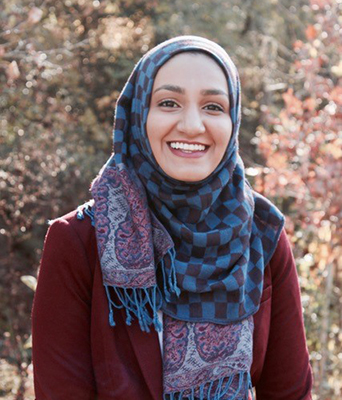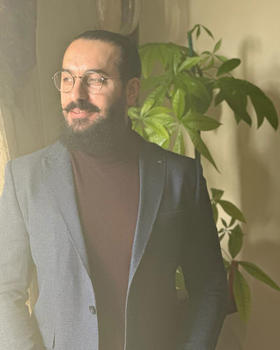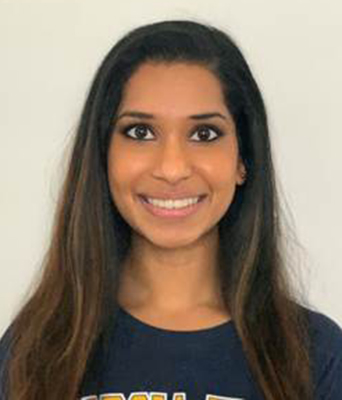Sameen Yusuf, GMU BS in BIOE, Fall 2017

My coursework at Mason built a foundation in engineering concepts; my experiences with Engineering World Health, MedX, MasonWHO, and research taught me about the vitality of contextualizing a technology’s potential impact throughout the design process.
One of the most impactful experiences was my senior design project — under the mentorship of Lance Liotta and Alessandra Luchini at the Center for Applied Proteomics and Molecular Medicine (CAPMM), I worked with a team of bioengineering students to address gaps in affordable, sensitive, and user-friendly diagnostic tests for deadly communicable diseases such as tuberculosis. I learned about point-of-care diagnostics, nanotechnology, and proteomics at the lab. However, I wanted to bridge the gap between our team and the patients we were ultimately trying to help. After graduation, I pursued a Fulbright U.S. Student Research Fellowship in Kathmandu, Nepal to conduct a user acceptability study for our technology. With the help of a local nonprofit, we interviewed about 200 active TB patients, community health workers, microbiologists, and physicians regarding our urinary TB test technology.
Post-Fulbright, I am a Data Analyst at Socially Determined, a DC startup that created the first platform for analyzing clinical, financial, and social data. We integrate social risk, clinical disease burden, utilization patterns, and demographic data to identify opportunities for intervention that will impact the populations our clients serve.
"I found mentors and friends across multiple departments at Mason. Each individual helped me foster creativity and identify ways to integrate my interests across biomedical engineering, healthcare policy, and global health."
Forrest Bussler, GMU BS in BIOE, Summer 2017
General Engineer at Night Vision and Electronic Sensors Directorate
Volunteering in several Mason bioengineering labs, and then ultimately getting paid under the undergraduate research program, was an excellent opportunity to hone my critical thinking skills in independent research. Participating in Mason's OSCAR program was also an excellent opportunity to showcase my work to others and see what other undergraduates were doing in the research community. In regard to my current position, my two biomedical imaging classes were particularly important to understanding camera systems as well as how to perform image processing for various applications. Other particularly useful courses included Intro to Python and Data Analytics.
“Life is like a box of chocolates, make sure to read the back of the lid to pick the right flavor.”
Nashaat S. Rasheed, GMU Ph.D. in Bioengineering, Spring 2018

After graduating with my Ph.D. from the Bioengineering Department at GMU in 2018, as the first Bioengineering Ph.D. graduate, I joined the FDA as a biomedical engineer reviewer. Currently, I am a Science Policy Analyst in the Office of New Drugs (OND) in the Center for Drug Evaluation and Research (CDER) at the U.S. Food and Drug Administration (FDA) within the U.S. Department of Health and Human Services (HHS). In addition, I have been an adjunct professor at the W.E.B. Du Bois Scholars Institute – Accelerated Learning Academy (ALA) at Princeton University since 2021.
I conducted my Ph.D. research work in the Biomedical Imaging Lab with Dr. Parag Chitnis. We collaborated closely with my Ph.D. co-advisor Dr. Rob Cressman, who is affiliated with the Physics and Astronomy Department in the College of Science at GMU. My dissertation focused on studying the feasibility of photoacoustic (PA) sensing of bio-electrical activity, which relies on the absorption of light by voltage-sensitive probes and subsequent generation/detection of ultrasound.
As an Oak Ridge Institute for Science and Education (ORISE) fellow during my PhD candidacy at the FDA, I worked with the same imaging modality (PA imaging) as for my Ph.D. academic research at GMU, but with a different application for breast-cancer detection instead of sensing bio-electrical activity. I constructed and demonstrated the utility of tissue-mimicking phantoms as a test platform for investigating PA imaging artifacts and worked on developing test methods based on tissue-mimicking phantoms containing gold nanoparticles in blood vessel-mimicking fluid channels.
Because of GMU’s attractive geographical location to the various federal government agencies, I was able to conduct research work in the government while pursuing my Ph.D. studies and completing my academic research work. The combination of these research experiences equipped me to be an independent engineer and pushed me toward a career in government policy and regulatory science
"It is of high importance for GMU undergraduate and graduate students who are seeking research opportunities not to only consider the area of interest in bioengineering or other field of study, but also to make sure that (s)he is a good match with the Principal Investigator (PI) who will have a great impact on their academic and professional careers."
– Nashaat S. Rasheed, GMU PhD in Bioengineering, Spring 2018
Anuradha Nagulapati, GMU BS in BIOE, Spring 2017
As a Bioengineering student at Mason, I participated in several Bioengineering volunteering opportunities that sharpened and strengthened my technical skill set. Participating in senior design was an excellent opportunity to utilize knowledge gained over the years and collaborate with a team of other Bioengineering students and mentors. One of my favorite and most impactful experiences was my internship at the Inova Fairfax Hospital under Dr. Mahesh Shenai. I tested medical device instrumentation and designed neurosurgical activities for students participating in the BENG 499: “Bioengineering Applied Neurotechnologies” course for the Fall 2016 semester. During my internship, I developed a deep understanding of different imaging techniques to identify normal and abnormal anatomical structures, aided in analyzing CT/MRI scans, and was able to shadow surgeries such as deep brain stimulation. I also became the teaching assistant (TA) for this class during the Fall 2016 semester. This opportunity solidified my interest in pursuing a career in the medical device industry. Furthermore, I was involved in organizations such as the Biomedical Engineering Society and Pi Beta Phi that allowed me to succeed during my time at GMU.
Post GMU, I work as a regulatory affairs consultant for MCRA, LLC, a medical device firm. I draft and develop regulatory strategies and assessments for various device classes (I, II, and III), clinical evaluation reports, design dossiers, clinical protocols, and technical files with focus in orthopedic, spine, and cardiovascular medical devices for U.S. and international regulatory affairs. This Fall (2020), I will be attending Georgia Tech to pursue my M.S. in Biomedical Engineering - Biomedical Innovation and Development.
“Participating in senior design was an excellent opportunity to utilize knowledge gained over the years and collaborate with a team of other Bioengineering students and mentors.”


